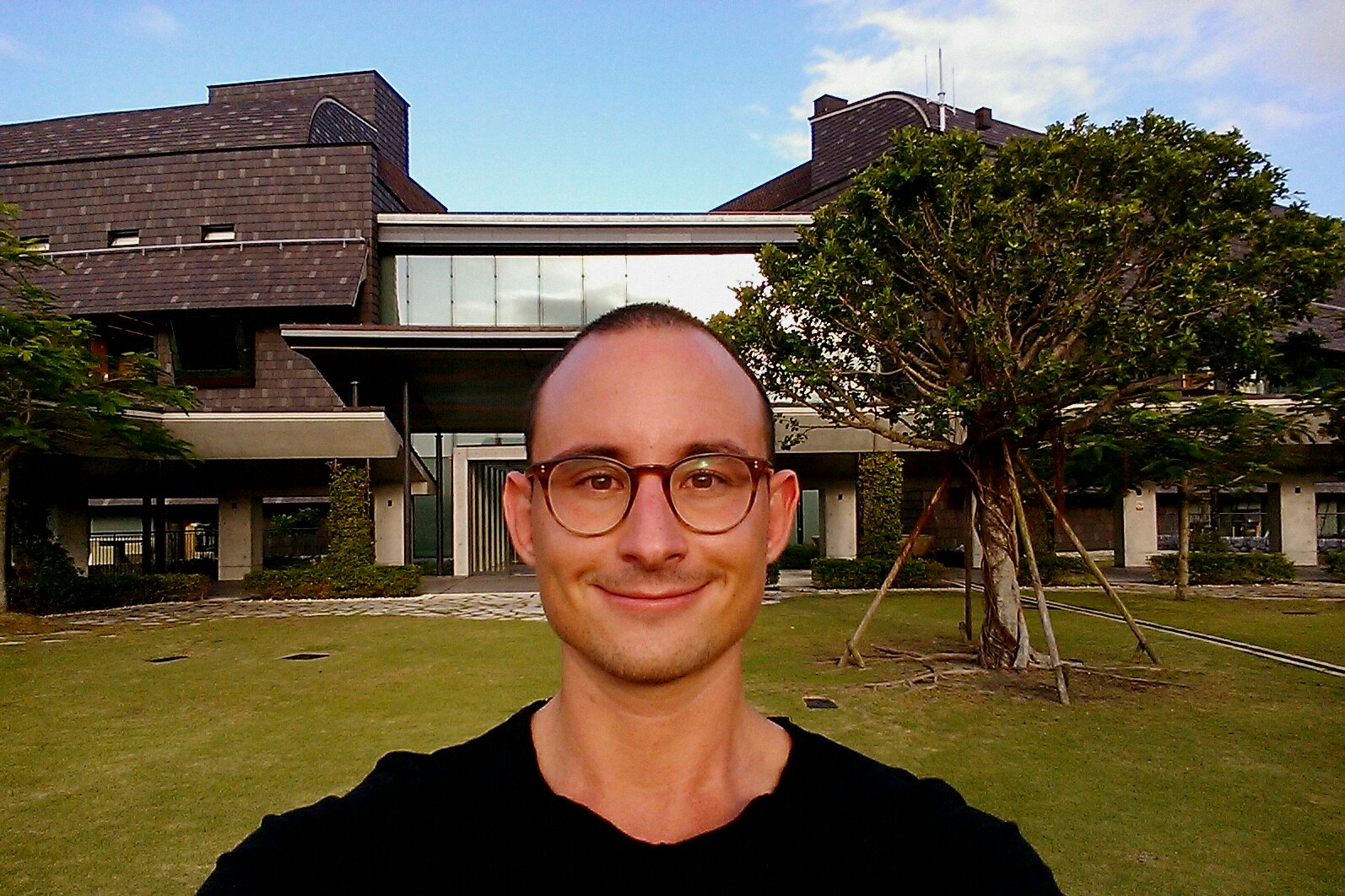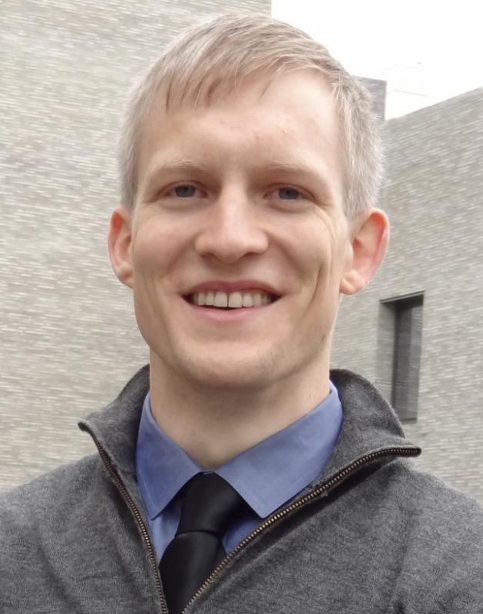FY2018
Micro/Bio/Nanofluidcs Unit
Professor Amy Shen
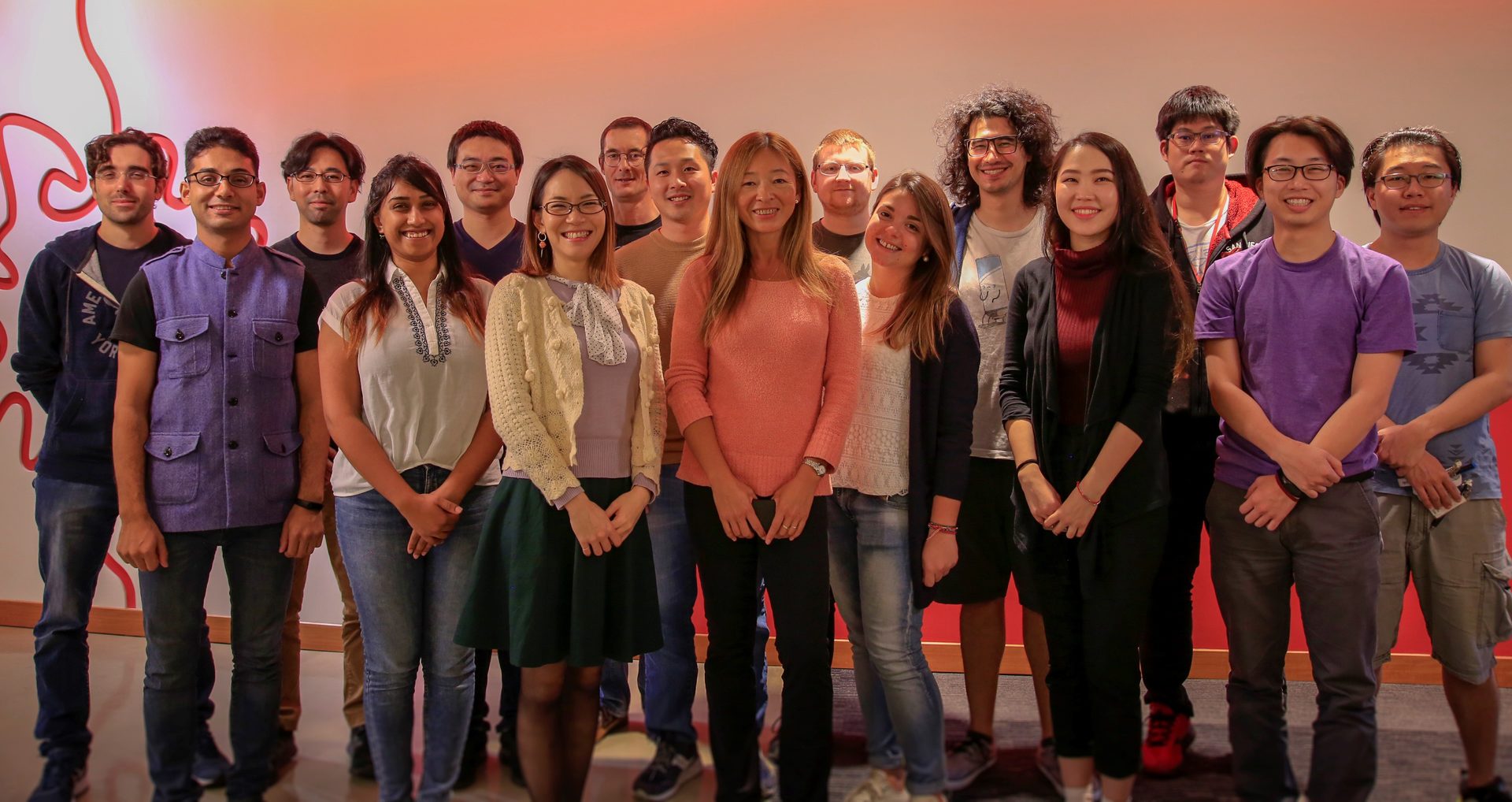
Abstract
In FY2018, Micro/Bio/Nanofluidics Unit (MBNU) continued to develop two core research themes: one on the fundamental aspects of micro- and nanofluidic flows, coupled with rheology; the other on microfluidics and technologies at the nano-biointerface. Members of the MBNU unit published 16 peer-reviewed papers in FY2018, with our research highlighted in Soft Matter, Physics of Fluids, Science Daily, etc. The unit members have also actively disseminated our research results to the general public and scientific communities. We have given 37 presentations and seminars in FY2018, and participated professional society meetings such as the micro-TAS, Annual European Rheology Conference (AERC), Society of Rheology Annual Meeting, the APS-DFD meeting, and 19th RIES-Hokudai International Symposium. Our unit members supported 5 community outreach activities such as OIST Science Festival 2018 and OIST Cafe in Tokyo. Prof. Shen also gave a rheology short course in Shanghai in April 2018, together with Prof. Chris Macosko and Prof. Gerry Fuller.
Our unit organized an OIST mini-symposium, titled "Flow and Instability of Self-Assembled Systems” in September 2018. Together with Waseda University, our unit also co-organized the 5th core-to-core international symposium “3D Lab-Exchange Program”, with participants from Waseda University, University of Bonn, NUS in Singapore, and IIT in Italy. We also hosted 16 researchers visiting OIST, with seminar topics ranging from microfluidics, rheology, and bio-MEMs.
Personnel wise, we welcomed Dr. Cameron Hopkins as a new postdoc. Ting-Chun Chou joined the team of our proof-of-concept project to develop GUI and software for smart phone interface. Dr. Nikhil Bhalla will start his faculty position in Ulster University, UK in May 2019. Dr. Mandy Leung just became a "Special Postdoctoral Researcher" in RIKEN. Our unit also hosted 5 research interns from University of Naples “Federico II”, Karlsruhe Institute of Technology, Eindhoven University of Technology, and University of Twente.
1. Group Members
As of March 31, 2019
• Prof. Amy Shen, Professor
• Dr. Simon Haward, Group Leader
• Dr. Nikhil Bhalla, Postdoctoral Scholar
• Dr. Atsushi Matsumoto, Postdoctoral Scholar
• Dr. Riccardo Funari, Postdoctoral Scholar
• Dr. Cameron Hopkins, Postdoctoral Scholar
• Mr. Kazumi Toda-Peters, Technician
• Mr. Kei Funakoshi, Technician
• Mr. Kang-Yu Chu, Technician (software and hardware development)
• Mr. Ting-Chun Chou, Technician (software development)
• Mr. Hsieh-Fu Tsai, Graduate Student
• Ms. Shivani Sathish, Graduate Student
• Ms. Noa Burshtein, Graduate Student
• Ms. Ainash Garifullina, Graduate Student
• Mr. San To Chan, Graduate Student
Alumni
• Dr. Francesco Del Giudice, Postdoctoral Scholar (Lecturer at Swansea University, UK)
• Dr. Mandy Leung, JSPS Postdoctoral Scholar (Researcher at Riken, Japan)
• Ms. Johanna Roether, Research Intern (Back to Karlsruhe Institute of Technology)
• Mr. Fernon Eijkhoudt, Research Intern (Back to the University of Twente)
• Mr. Bruno Miranda, Research Intern (Back to the University of Naples “Federico II”)
2. Collaborations
- Type of collaboration: Joint research
- Researchers:
- Professor Tamer Zaki, Johns Hopkins University, USA
- Professor Anke Lindner, ESPCI Paris, France
- Professor Norbert Willenbacher, Karlsruhe Institute of Technology, Germany
- Professor Pier Luca Maffettone, University of Naples “Federico II”, Italy
- Professor Tsutomu Takahashi, Nagaoka University of Technology, Japan
- Professor Amy Shen, OIST
- Dr. Simon Haward, OIST
- Dr. Lucie Ducloue, ESPCI Paris, France
- Mr. Steffen Recktenwald, Karlsruhe Institute of Technology, Germany
3. Activities and Findings
3.1 Vortex dynamics in microfluidics
3.1.1 Vortex Breakdown in a dividing microfluidic T-channel
S. T. Chan, S. J. Haward and A. Q. Shen, "Microscopic investigation of vortex breakdown in a dividing T-junction flow", Physical Review Fluids, 3, 072201(R), (2018).
We developed a novel glass microfluidic, enabling to capture the first clear visualization of vortex breakdown in a dividing T-junction flow (Fig. 1). By individual control of the inflow and two outflows, we show that even slight outflow imbalances can greatly alter the structure of vortex breakdown, by creating a net pressure difference across the junction. Our results are summarized in a dimensionless phase diagram, which will guide the use of vortex breakdown in T-junctions to achieve specific flow manipulation (Fig. 1). As inertial microfluidics is becoming more important in manipulating fluids in lab-on-a-chip devices, our results demonstrate the importance of accurate device design and flow control to avoid design failure or data misinterpretation in microfluidic experiments involving flow deceleration and vorticity decay.
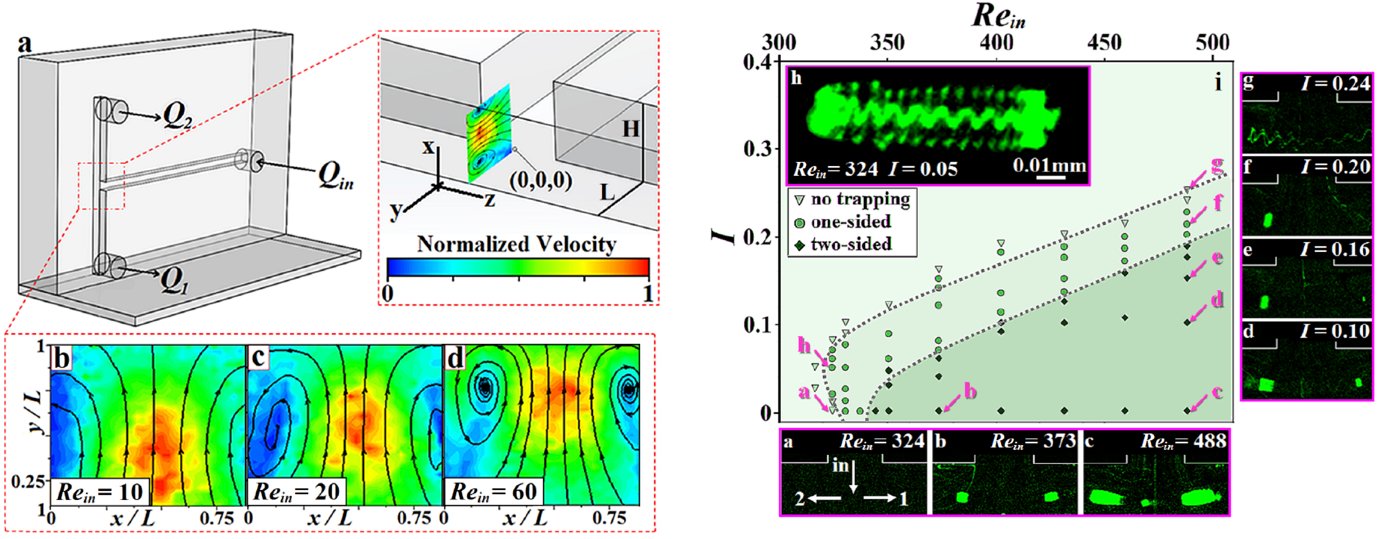
Figure 1: Left: Schematic of the glass T-junction device. Right: Particle trapping under various flow conditions and flow imbalance.
3.1.2 Controlled symmetry breaking and vortex dynamics in intersecting flows
Noa Burshtein, Amy Q. Shen, and Simon J. Haward, "Controlled symmetry breaking and vortex dynamics in intersecting flows", Physics of Fluids, 31: 034104, (2019).
breaking flow instability at a 4-way intersection. By precisely controlling the flow rate (hence the Reynolds number, Re) of the flow about a critical value, we are able to induce the merging of two co-rotating vortices into a single structure and similarly to induce a single vortex to split into two. Using quantitative flow velocimetry, both processes are recorded with high spatial and temporal resolution. We find that both the merging and the splitting of vortices are exponential processes, with a rate that depends on the imposed Re. The vortex dynamics in our system are intimately connected with the symmetry-breaking transition and are affected by the degree of vortex confinement, which we control by varying the aspect ratio (α) of the flow geometry. We show how the confinement affects the fundamental nature of the flow transition, which varies from super through subcritical as α is increased. Our results are of direct relevance to understanding and predicting flow transitions and vortex dynamics in flow intersections, particularly in confined environments such as in microfluidic (lab-on-a-chip) devices and in the circulatory system and may be relevant to the prediction of vortex interactions in general.

Figure 2. (a) A schematic diagram of the experimental setup, which allows a direct observation of the x = 0 plane on an inverted microscope. Inflow (along y) is indicated by the blue arrows, and outflow (along x) is indicated by the red arrows. (b) Schematic diagram of a vortex in the cross-slot device for flow at Re > Rec; d and w are the channel depth and width, respectively. [(c)–(e)] μ-PIV images of the vorticity field at x = 0: (c) a symmetric flow field with four cells of Dean vortices; (d) an asymmetric flow field where two intensified Dean vortices have commenced to merge; and (e) a single steady, central streamwise vortex is formed by the merging of the two Dean vortices.
3.2 Bifurcation and instability in microscopic flows of complex fluids
3.2.1 Inertioelastic Poiseuille Flow Over a Wavy Surface
Simon J. Haward, Jacob Page, Tamer A. Zaki, Amy Q. Shen, "Inertioelastic Poiseuille Flow Over a Wavy Surface", Physical Review Fluids, 3, 091302(R) (2018)
Streamwise boundary undulations induce spanwise vorticity in flows. In Newtonian flow, vorticity decays exponentially with distance from the undulation. However, recent theory for inertioelastic polymeric flow predicts vorticity amplification in a “critical layer” far from the site of disturbance. Here we present the first experimental evidence for the existence of such critical layers, demonstrating their measurable role in real polymeric flows with inertia. These vorticity amplification effects should be considered in all evaluations of vorticity dynamics in inertioelastic flows with streamline curvature.
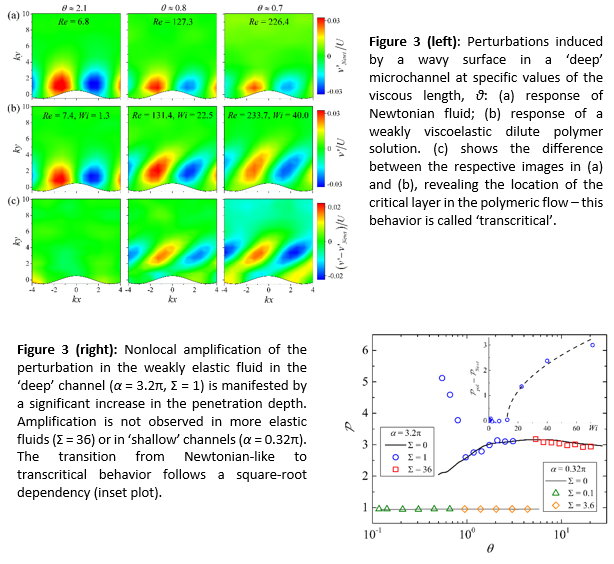
3.2.2 Flow of Wormlike Micellar Solutions Around Microfluidic Cylinders with High Aspect Ratio and Low Blockage Ratio
Simon J. Haward, Naoyuki Kitajima, Kazumi Toda-Peters, Tsutomu Takahashi and Amy Q. Shen, "Flow of Wormlike Micellar Solutions Around Microfluidic Cylinders with High Aspect Ratio and Low Blockage Ratio", Soft Matter, 15, 1927-1941 (2019)
We employ time-resolved flow velocimetry and birefringence imaging methods to study the flow of a well-characterized shear-banding wormlike micellar solution around a novel glass fabricated microfluidic circular cylinder. In contrast with typical microfluidic cylinders, our geometry is characterized by a high aspect ratio α = H/W = 5 and a low blockage ratio β = 2r/W = 0.1, where H and W are the channel height and width, and the cylinder radius r = 20 μm. The small cylinder radius allows access up to very high Weissenberg numbers 1.9 ≤ Wi = λMU/r ≤ 3750 (where λM is the Maxwell relaxation time) while inertial effects remain entirely negligible (Reynolds number, Re < 10-4). At low Wi values, the flow remains steady and symmetric and a birefringent region (indicating micellar alignment and tensile stress) develops downstream of the cylinder. Above a critical value Wic ≈ 60 the flow transitions to a steady asymmetric state, characterized as a supercritical pitchfork bifurcation, in which the fluid takes a preferential path around one side of the cylinder. At a second critical value Wic2 ≈ 130, the flow becomes time-dependent, with a characteristic frequency f0 ≈ 1/λM. This initial transition to time dependence has characteristics of a subcritical Hopf bifurcation. Power spectra of the measured fluctuations become complex as Wi is increased further, showing a gradual slowing down of the dynamics and emergence of harmonics. A final transition at very high Wic3 corresponds to the re-emergence of a single peak in the power spectrum but at much higher frequency. We discuss this in terms of possible flow-induced breakage of micelles into shorter species with a faster relaxation time.
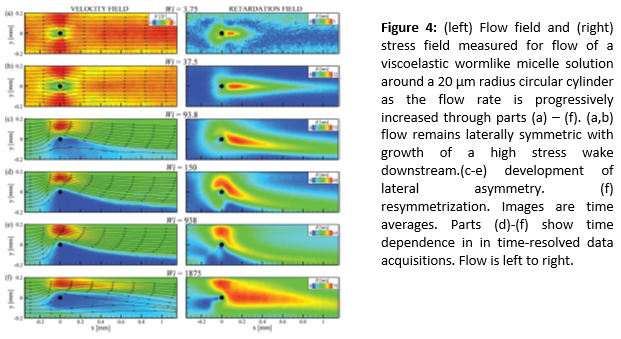
3.3 Microfluidics for biomedical engineering applications
3.3.1 Organizing particle trains using viscoelastic fluids in a straight microfluidic channel
Francesco Del Giudice, Gaetano D’Avino, Francesco Greco, Pier Luca Maffettone, and Amy Q. Shen, "Fluid viscoelasticity drives self-assembly of particle trains in a straight microfluidic channel", Physical Review Applied, 10, 064058, (2018)
Self-assembly of equally-spaced flowing particles on a single streamline (particle train) is highly desirable in a variety of microfluidic applications. So far, single-line particle trains have been observed in proximity of the microchannel wall, by using inertial microfluidic. However, the high particle rotation and large local shear gradient near the microchannel walls can negatively affect applications related to flow cytometry and potentially lead to cell damage. To overcome these issues, particle trains should develop along the channel centreline where particle rotation and local shear gradient are minimal. In this work, we demonstrate the first experimental evidence of particle ordering in viscoelastic liquids, under inertialess conditions. A simple addition of 1 wt% hyaluronic acid biopolymer to an aqueous suspension drives self-assembly of a single-line particle train in a square-shaped straight microchannel. Particles of 20 m in diameter can be ordered in a microchannel with 100 m width, with a throughput up to ~2400 particles/s. Numerical simulations are in good agreement with our experiments, and a qualitative stability analysis of the train configuration supports the experimental and simulation results.
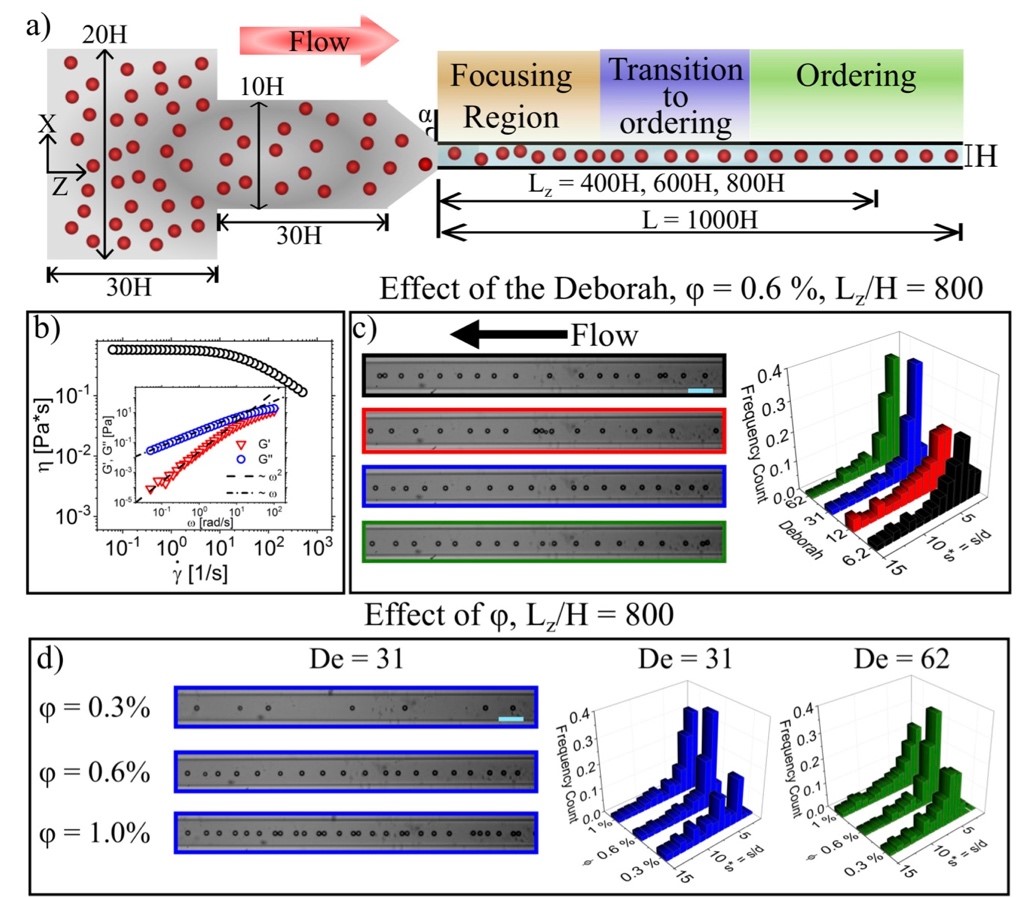
Figure 5. a) Schematic of the employed device with relevant dimensions. Particles converge gently to the glass channel, align after a certain length, and then self-order. The device in grey is a multi-contraction inlet made of polymethylmethacrylate. b) Shear viscosity as a function of the shear rate for hyaluronic acid (HA) at 1 wt% in PBS. The longest relaxation time is 37 ms. c) Higher Deborah numbers De enhances the fraction of particles ordered at s/d ≥ 3.5, where d = 20 μm is the particle diameter. Experimental snapshots at different De are also shown (same color code of the histograms). Flow is from right to left. Volumetric particle fraction is 0.6%. d) Particle ordering occurs at volumetric particle concentrations > 0.3%. Scale bar is 100 μm.
3.3.2 Quick-fit hybrid microdevice to study cell-cell interactions
Hsieh-Fu Tsai, Kazumi Toda-Peters, Amy Q. Shen, "Glioblastoma adhesion in a quick-fit hybrid microdevice", Biomedical Microdevices, 21:30 (2019).
Translational biomedical research requires reliable biomedical microdevices (BMMD) to quantitively study models in mimicked physiological conditions and answer biological questions. We introduce a reversibly sealed quick-fit hybrid BMMD that is operator-friendly and bubble-free also requires low reagent consumption, low cell number requirement, and enables robust high throughput experiments. The hybrid BMMD combines the advantages of poly(methyl methacrylate) (PMMA) and poly(dimethyl siloxane) (PDMS) and mitigates the disadvantages of the two materials. We build a prototype of hybrid BMMD with reversible sealing to illustrate its utilities by studying the adhesion of glioblastoma cells T98G and U251MG cells to primary HUVEC endothelial cell layers conditioned with electric field and shear flow. We confirmed that angionpoietin-Tie2 signalling cascade increases the adhesion of glioblastoma cells to endothelial cells while the intercellular transport events were not affected. Furthermore, we have shown that EF and shear flow modulate the orientation of endothelial cells in perpendicular and parallel to electric current and flow current, respectively. The endothelial cells orientate parallelly to the shear flow with 1 Pa shear flow. Under electric field with strength more than 154 V/m, the perpendicular alignment induced by electric field overpowers the effect of shear flow. Also, only T98G glioblastoma cells shows increased adhesion to conditioned endothelial cells but not U251MG suggesting further identification of adhesion molecules participating in glioblastoma-vasculature interaction is important. The quick-fit hybrid BMMD provides a simple and flexible platform to create multiplex systems, making it possible to investigate complicated biological conditions for translational research.
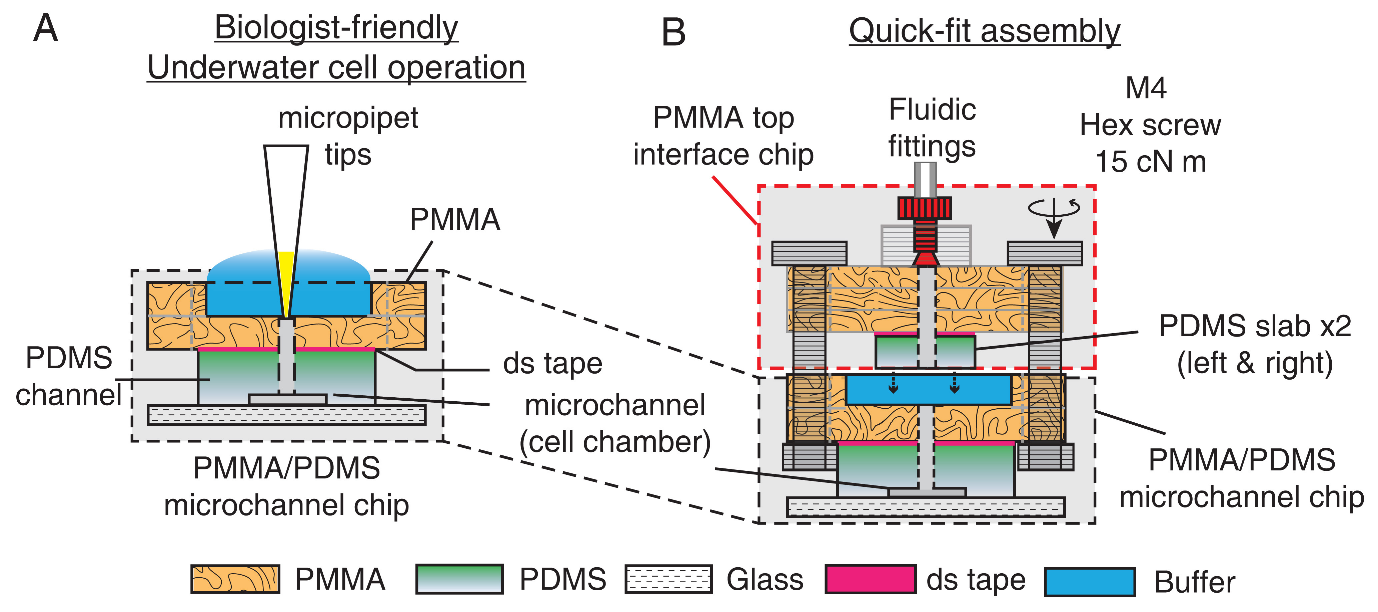
(a)
Figure 6. The working principle of the quickfit hybrid BMMD. (A) The manipulation of cells is easy in biologist friendly underwater operation. This method also prevents microbubbles that may cause cell death. (B) After appropriate cell preparation, multiplex microenvironment on chip can be created using the quick-fit assembly and study biological questions in high throughput by reusing the PMMA top interface chip with different microchannel chips.
3.3.3 Instance-aware cell tracking enhanced by machine learning
Hsieh-Fu Tsai, Joanna Gajdac, Tyler Sloan, Andrei Rarese, Amy Q. Shen, "Usiigaci: Label- free instance-aware cell tracking under phase contrast microscopy using machine learning", SoftwareX, 9, 230–237, (2019)
Quantitative analysis of single-cell migration and morphology changes is essential to further our understanding in cell biology. To achieve the goal, single-cell segmentation and tracking in model microenvironment under microscopy is essential and is tantamount to the holy grail of microscopic cellular dynamic analysis. Phase contrast microscopy (PCM) is a brightfield microscopy technique favoured by biomedical community for its ability to enhance the contrast of transparent cellular structures, but the images under PCM is also notoriously difficult to segment accurately at high cellular density. We introduce an open-source all-in-one software named Usiigaci, which means tracing of object in Ryukyuan dialect, to segment, track, and analyse single cell migration (Figure 1). Stain-free, instance-aware segmentation is accomplished by using a mask regional convolutional neural network (Mask R-CNN). A Trackpy-based cell tracker with a graphical user interface is developed to track and link the cells and enable users to validate the tracked results. Quantitative cell migration analysis is then performed to yield intuitively understandable results and visualization. Usiigaci provides highly accurate cell movement and morphological information for quantitative cell migration analysis that will be beneficial for biomedical community and pharmaceutical industry to study single cell-level questions and drug screening.
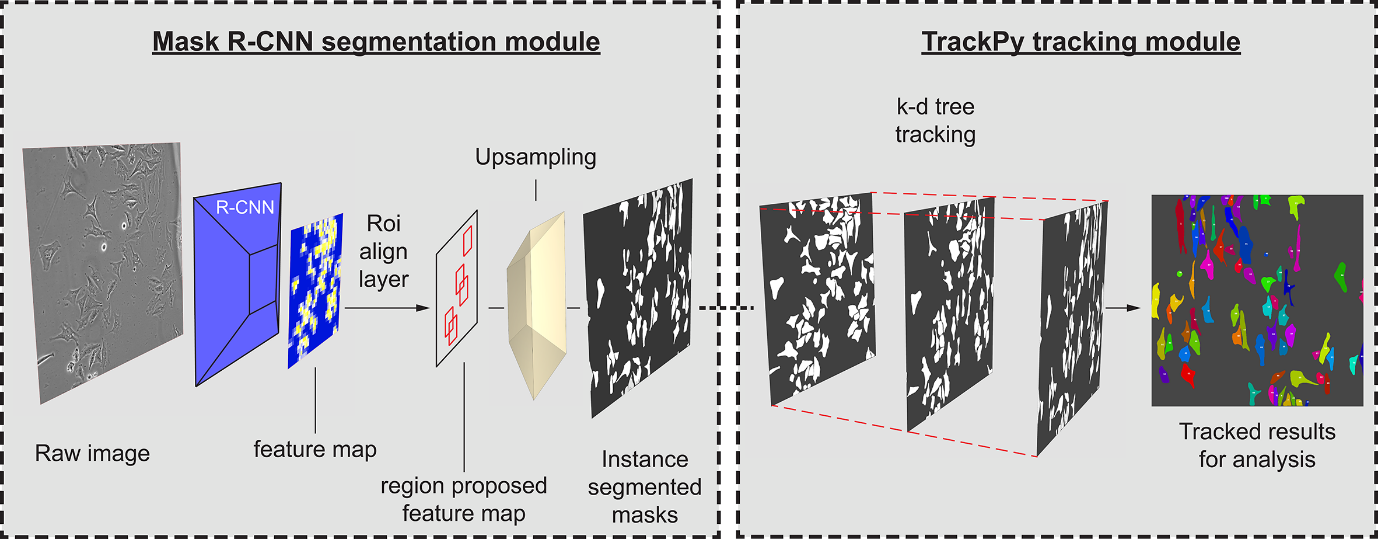
Figure 7: The simplified diagram of Usiigaci workflow. The raw phase contrast images are fed through the Mask R-CNN neural network which will generate instance segmented masks. The region of interests in the segmented masks are then tracked and linked in the tracking module. Afterward, tracked results are analysed in the analysis module.
3.4 Developing biosensors at the nano-biointerface
Our unit recently developed nanoplasmonic materials that can be incorporated into biosensors, serving as highly sensitive transducing elements of the system. Nanomaterials made of gold, silver, graphene and carbon in the form of nanoparticles, nanotubes, and nanofilms often display superior biosensing performance due to their unique electronic and optical properties at nanoscale.
3.4.1 Monitoring Bacterial Biofilm Formation Using LSPR Sensors for Drug Screening
Riccardo Funari, Nikhil Bhalla, Kang-Yu Chu, Bill Söderström, Amy Q. Shen, "Nanoplasmonics for real-time and label-free monitoring of microbial biofilm formation", ACS Sensors, 3(8):1499-1509, (2018)
This work demonstrates highly biocompatible nanoplasmonic sensor, which utilizes the principle of localized surface plasmon resonance (LSPR) to monitor the biofilm formation of E. coli bacteria. The developed sensor is label-free and monitors the biofilm formation in real-time with a resolution of 1 minute. Further, we show that this sensor can be used to discover potential inhibitors of bacterial biofilms. Due to simplicity and flexibility of the developed LSPR platform, this sensor can be used to test a variety of clinically relevant bacteria, representing an important innovation in biomedical research.
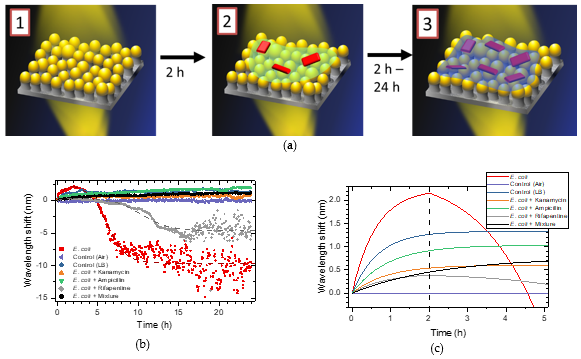
Figure 8. a) Sketch describing the stages of biofilm formation on the sensor chip. 1) LSPR naked substrate; 2) Early bacterial adhesion and formation of a conditioning layer on the sensor occurring in the first 2 hours and 3) biofilm maturation. b) Real-time monitoring of bacterial adhesion and biofilm formation. Resonance wavelength versus time for the control (LB), E. coli, and E. coli growing in the presence of various antibiotics and antibiotic mixture (kanamycin: 100 μg/mL, ampicillin: 100 μg/mL, rifapentine: 1 μg/mL). The stability of the sensing platform is evaluated by measuring the resonance peak of the LSPR biochip for 24 h when exposed to air (purple triangles). c) Magnification of the sensor response trends for the first 5 h.
3.4.2 Silver-based LSPR biosensors
Nikhil Bhalla, Afshan Jamshaid, Mandy Hei Man Leung, Noriko Ishizu, Amy Q. Shen, "Electrical Contact of Metals at the Nanoscale Overcomes the Oxidative Susceptibility of Silver- Based Nanobiosensors", ACS Applied Nano Materials, 2019, DOI: 10.1021/acsanm.9b00066.
Oscillation of surface electrons associated with the localized surface plasmon resonances (LSPR) is a characteristic feature of silver (Ag) at nanoscale. However, fundamental material limitations associated with oxidation of Ag in wet environments lead to poor adhesion of Ag on dielectrics such as SiO2. With the use of titanium (Ti), we overcome this physical instability associated with oxidization of silver at nanoscale. The fabrication procedure involves double dewetting of thin films of silver (≤ 8 nm) and titanium (2 nm) at 250 oC on glass surfaces. The resulting Ag/Ti nanoislands (NI) are found to strongly adhere on SiO2 in wet environments, even when exposed to harsh organic solvents such as acetone and isopropanol. We hypothesize that the electrical contact between Ag and Ti leads to the transfer of electrons from Ti to Ag. This transfer of electrons from one metal to the other can be explained by galvanic coupling of metals where the contact between Ti and Ag results in the cathodic protection of Ag. Furthermore, the Ag/Ti NI have a sensitivity of 112 nm/RIU towards refractive index sensing applications and a shelf life of over 100 days. We also achieved the detection of human C-reactive protein on Ag/Ti NI with a limit of detection of 80 fM, suggesting its use for a wide range of biochemical sensing applications.
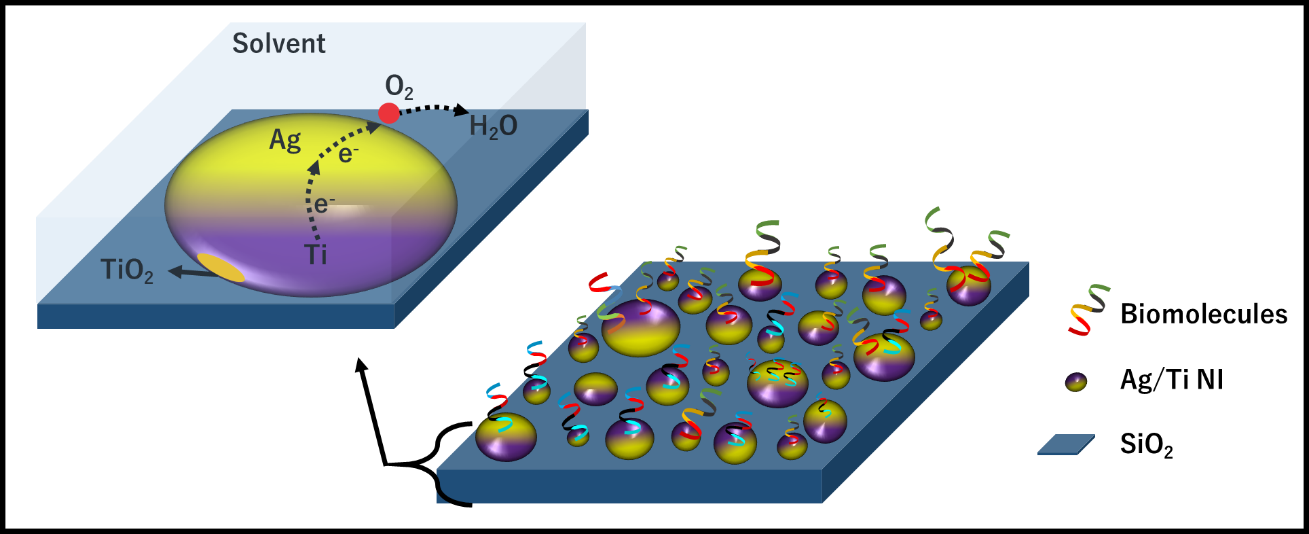
Figure 9. By using a simple 2-step thermal dewetting protocol, we fabricate bimetallic Ag and titanium nanoislands (Ag/Ti NI) on top of SiO2 surfaces, where Ti suppresses the Ag from its oxidation in wet environments.
3.5 Rheological studies of polymeric ionic liquids
Atsushi Matsumoto, Francesco Del Giudice, Rachapun Rotrattanadumrong, Amy Q. Shen, "Rheological Scaling of Ionic Liquid-Based Polyelectrolytes in Ionic Liquid Solutions", Macromolecules, (2019). DOI: 10.1021/acs. Macromol. 8b02544
Polymerized ionic liquids (PILs) are a special class of polyelectrolytes with ionic liquid (IL) species being covalently attached to the repeating unit. The rheological properties of PIL in IL solutions are strongly influenced by the electrostatic screening between IL and PIL chains. However, the effect of IL electrostatic screening on the rheology of PIL in IL solutions remains elusive. To address this challenging yet important question, we conduct detailed rheological characterization of a model system containing a PIL (PC4-TFSI: poly(1-butyl-3-vinylimidazolium bis(trifluoromethanesulfonyl)imide) in a mixture of a salt-free solvent (DMF: dimethylformamide) and an IL (Bmim-TFSI: 1-butyl-3-methylimidazolium bis(trifluoromethanesulfonyl)imide) solution, with low to high IL concentrations, while spanning dilute and semidilute polymer regimes. We compare the specific viscosity and the longest relaxation time of PILs measured at various Bmim-TFSI concentrations from 0 M (pure DMF) to 3.42 M (pure Bmim-TFSI) with the scaling predictions for ordinary polyelectrolyte solutions. We find good agreement at low IL concentrations, but significant deviations at higher IL concentrations (see Figures 1(a) for and 1(b) for at a monomer concentration of with varying IL concentrations ). We capture this discrepancy by proposing and validating a modified scaling law accounting for the modified screening length in concentrated solutions of ordinary salts. We propose that extended PIL chains initially shrink due to the charge screening effect at low IL concentrations, but revert to expanded configuration at higher IL concentrations due to the charge underscreening effect when the screening length increases with increasing IL concentrations. Our results shed new insights on the conformation of PIL in IL solutions, and for the first time, provide a valid reference for the study of general polyelectrolyte solutions at high salt concentrations, where the Debye-H ckel theory is no longer valid.

Figure 10. Specific viscosity (circles in a) and longest relaxation time (squares in b) dependence on the ionic liquid concentration. The blue and red solid curves represent the scaling predictions by Dobrynin et al. for polyelectrolyte solutions in the semidilute unentangled and dilute regimes. The red dashed curve represents a modified scaling theory in the dilute regime proposed in our study, accounting for the modified screening length in concentrated salt solutions.
4. Publications
4.1 Journals
1. Matsumoto, Atsushi, Del Giudice, Francesco, Rotrattanadumroung, Rachapun, Shen, Amy Q, Rheological Scaling of Ionic-Liquid-Based Polyelectrolytes in Ionic Liquid Solutions, Macromolecules, (2019). DOI: 10.1021/acs.macromol.8b02544.
2. Noa Burshtein, San To Chan, Kazumi Toda-Peters, Amy Q. Shen, Simon J. Haward, 3D-printed glass microfluidics for fluid dynamics and rheology, Current Opinion in Colloid & Interface Science, 43: 1-14, (2019). DOI: 10.1016/j.cocis.2018.12.005.
3. Noa Burshtein, Amy Q. Shen, Simon J. Haward, Controlled symmetry breaking and vortex dynamics in intersecting flows, Physics of Fluids, 31: 034104, (2019). DOI: 10.1063/1.5087732.
4. L. Ducloue, L. Casanellas, S. J. Haward, R. J. Poole, M. A. Alves, S. Lerouge, A. Q. Shen, A. Lindner, Secondary flows of viscoelastic fluids in serpentine microchannels, Microfluidics and Nanofluidics, 23: 33, (2019). https://doi.org/10.1007/s10404-019-2195-0
5. Simon J. Haward, Naoyuki Kitajima, Kazumi Toda-Peters, Tsutomu Takahashi and Amy Q. Shen, Flow of wormlike micellar solutions around microfluidic cylinders with high aspect ratio and low blockage ratio, Soft Matter, 15 (9), 1893-2104, (2019). DOI: 10.1039/c8sm02099j.
6. Nikhil Bhalla, Afshan Jamshaid, Mandy Hei Man Leung, Noriko Ishizu, and Amy Q Shen, Electrical Contact of Metals at the Nanoscale Overcomes the Oxidative Susceptibility of Silver-Based Nanobiosensors, ACS Applied Nano Materials, (2019). DOI: 10.1021/acsanm.9b00066.
7. Hsieh-Fu Tsai, Joanna Gajdac, Tyler Sloan, Andrei Rarese, Amy Q. Shen, Usiigaci: Label-free instance-aware cell tracking under phase contrast microscopy using machine learning, SoftwareX, 9, 230-237, (2019). DOI: 10.1016/j.softx.2019.02.007.
8. Hsieh-Fu Tsai, Kazumi Toda-Peters, Amy Q. Shen, Glioblastoma adhesion in a quick-fit hybrid microdevice, Biomedical Microdevices, 21:30, (2019). DOI: 10.1007/s10544-019-0382-0.
9. Francesco Del Giudice, Gaetano D'Avino, Francesco Greco, Pier Luca Maffettone, Amy Q. Shen, Fluid viscoelasticity drives self-assembly of particle trains in a straight microfluidic channel, Physical Review Applied, 10, 064058, (2018).
10. Rameez Iqbal, Butunath Majhy, Amy Q. Shen and Ashis Sen, Evaporation and morphological patterns of bi-dispersed colloidal droplets on hydrophilic and hydrophobic surfaces, Soft Matter, 14, 9901-9909, (2018).
11. Nikhil Bhalla, Hung-Ju Chiang, Amy Q. Shen, Book Chapter, Cell biology at the interface of nanobiosensors and microfluidics, Book Chapter in "Microfluidics in Cell Biology Part C--Microfluidics on a Molecular Scale", Vol 148, Elsevier, December 2018.
12. Simon J. Haward, Jacob Page, Tamer Zaki, Amy Q. Shen, "Phase Diagram" for Viscoelastic Poiseuille Flow Over a Wavy Surface, Physics of Fluids, 30, (2018).
13. Simon J. Haward, Jacob Page, Tamer Zaki, Amy Q. Shen, Inertioelastic Poiseuille flow over a wavy surface, Physical Review Fluids, 3, 091302(R), (2018).
14. Riccardo Funari, Nikhil Bhalla, Kang-Yu Chu, Bill Soderstrom, Amy Q. Shen, Nanoplasmonics for real-time and label-free monitoring of microbial biofilm formation, ACS Sensors, 3, 8, 1499-1509, (2018).
15. San To Chan, Simon J. Haward, Amy Q. Shen, Microscopic Investigation of Vortex Breakdown in a Dividing T-Junction Flow, Physical Review Fluids, 3, 072201(R), (2018).
16. Atsushi Matsumoto, Ciprian Iacob, Takeru Noda, Osamu Urakawa, James Runt, Tadashi Inoue, Introducing Large Counteranions Enhances the Elastic Modulus of Imidazolium-Based Polymerized Ionic Liquids, Macromolecules, 51, 11, 4129-4142, (2018).
4.2 Books and other one-time publications
Nothing to report
4.3 Oral and Poster Presentations
- Toda-Peters, Kazumi, Haward, Simon J., Shen, Amy Q., 3D Printed Glass: Novel Microfluidic Device Fabrication Using Selective Laser-induced Etching, 3D printing technology and innovations, Rome, Italy, Mar 25-26 (2019).
- Garifullina, A., Bhalla, Nikhil, Shen, Amy Q., Comparative study of nanostructured Au functionalization, 5th Core-to-Core International Symposium, OIST, Okinawa, Japan, Feb 25-26 (2019)
- Funari, Riccardo, Bhalla, Nikhil, Shen, Amy Q, Nanoplasmonics for Real-Time and Label-Free Monitoring of Microbial Biofilm Formation, 5th Core-to-Core International Symposium, OIST, Okinawa, Japan, Feb 25-26 (2019).
- Kei Funakoshi, Shivani Sathish, Kazumi Toda-Peters, Amy Q. Shen, A microfluidic device for bead-based immunoassay, 5th Core-to-Core International Symposium, OIST, Okinawa, Japan, Feb 25-26 (2019).
- Amy Q. Shen, Nanoplasmonic platforms for multiple biosensing applications, 5th Core-to-Core International Symposium, OIST, Okinawa, Japan, Feb 25 (2019).
- Shen, Amy Q., Biocompatible large-scale nanoplasmonic structures for biosensing and long-term monitoring of cell proliferations, International Conference on Small Science (ICSS), Hawaii, USA. Mar 28 (2019).
- Matsumoto, Atsushi, Del Giudice, Francesco, Rotrattanadumroung, Rachapun, Shen, Amy Q., Electroviscous Effects on Rheological Properties of Polymerized Ionic Liquids in Ion Condensed Solutions, The Society of Rheology 90th Annual Meeting, Houston, Texas, USA, Oct 17 (2018).
- Matsumoto, Atsushi, Del Giudice, Francesco, Rotrattanadumroung, Rachapun, Shen, Amy Q., Rheological Scaling of Polymerized Ionic Liquids: from Salt-Free to Ion Condensed Solutions, The Society of Rheology 90th Annual Meeting, Houston, USA, Oct 15 (2018).
- Leung, Mandy H. M., Shen, Amy Q., Microfluidic Synthesis of Polymer Nanoparticles for the Delivery of Curcumin, The 12th Annual IEEE International Conference on Nano/Molecular Medicine and Engineering (IEEE-NANOMED 2018), Hawaii, USA, Dec 4 (2018).
- Haward, Simon J., Toda-Peters, Kazumi, Shen, Amy Q., Steady viscoelastic flow around high-aspect-ratio, low-blockage-ratio microfluidic cylinders, 90th Society of Rheology Annual Meeting, Houston, USA, Oct 14-18 (2018).
- Haward, Simon J., Page, Jacob, Zaki, Tamer A., Shen, Amy Q. Experimental investigation of viscoelastic effects in wavy microchannel flow, 71st American Physical Society Division of Fluid Dynamics Annual Meeting, Atlanta, GA, USA, Nov 18-20 (2018).
- Haward, Simon J., Kitajima, Naoyuki, Toda-Peters, Kazumi, Takahashi, Tsutomu, Shen, Amy Q., Flow and instability of a wormlike micellar solution around a microfluidic cylinder, 66th meeting of the Japan Rheological Society, Fukuoka, Japan, Oct 17-19 (2018).
- Ducloue, Lucie, Casanellas, Laura, Haward, Simon J., Poole, Robert J., Alves, Manuel A., Lerouge, Sandra, Shen, Amy Q., Lindner, Anke, Viscoelastic secondary flows in curved microchannels, 71st American Physical Society Division of Fluid Dynamics Annual Meeting, Atlanta, GA, USA, Nov 18-20 (2018).
- Chan, San To, Haward, Simon J., Shen, Amy Q., Flow recirculation in microfluidic T-junctions and bends, 71st American Physical Society Division of Fluid Dynamics Annual Meeting, Atlanta, GA, USA, Nov 18-20 (2018).
- Burshtein, Noa, Zografos, Kostis, Poole, Robert J.,Shen, Amy Q., Haward, Simon J., Inertioelastic flow instability at a stagnation points, 71st American Physical Society Division of Fluid Dynamics Annual Meeting, Atlanta, GA, USA, Nov 18-20 (2018).
- Shen, Amy Q., Flow instabilities in Microfluidics, 19th RIES-Hokudai International Symposium, Hokkaido, Japan, Dec 12 (2018).
- Shen, Amy Q., Nanoplasmonic platforms for multiple biosensing platforms, The 22nd International Conference on Miniaturized Systems for Chemistry and Life Sciences (micro-TAS), Kaohsiung, Taiwan, Nov 13 (2018).
- Haward, Simon J., Microfluidic Flows and Instabilities of Wormlike Micellar Solutions, COFTEC2018, Kyoto, Japan, Oct 26 (2018).
- Burshtein, Noa., Zografos, Konstantinos, Shen, Amy Q., Poole, Robert J., Haward, Simon J., Inertioelastic flow instability at a stagnation point, OIST Mini-Symposium "Flow and Instability of Self-Assembled Systems", OIST, Okinawa, Japan Sep 13 (2018).
- Haward, Simon J., Flow and Instability of Wormlike Micellar Solutions Around Microfluidic Cylinders, OIST Mini-Symposium "Flow and Instability of Self-Assembled Systems", OIST, Okinawa, Japan Sep 13 (2018).
- Shen, Amy Q., Microfluidic Assisted Nanoprecipitation of Curcumin Encapsulated PLGA Nanoparticles, European Advanced Materials Congress, Stockholm, Sweden, Aug 20-23 (2018).
- Shen, Amy Q., Biocompatible large-scale nanoplasmonic structures for biosensing and long-term monitoring of cell proliferations, European Advanced Materials Congress, Stockholm, Sweden, Aug 20-23 (2018).
- Shen, Amy Q., Hydrodynamics of micro/Nanofluidics for microbial applications, Symposium for Microbial Control 3.0, Tsukuba Global Science Week, Tokyo, Japan, Sep 21 (2018).
- Shen, Amy Q., Nanoplasmonic Biosensors: From Innovative Materials to Multimode Sensing with Integrated Microdevices, Lab-on-a-Chip & Microfluidics EUROPE 2018, Rotterdam, Netherlands, Jun 5 (2018).
- Shen, Amy Q., Haward, Simon J., Cardiel, Joshua, Zhao, Ya, Microstructure, Rheology, and Flow Instability of Wormlike Micellar Solutions under Spatial Confinement and Flow Conditions, Pacific Rim Conference on Rheology, Jeju Island, South Korea, Jun 10-15 (2018).
- Burshtein, Noa, Zografos, Kostis, Shen, Amy Q., Poole, Robert J., Haward, Simon J., Inertioelastic Flow Instability at a Stagnation Point, Annual European Rheology Conference, Sorrento, Italy, Apr 17-20 (2018).
- Del Giudice, Francesco, D'Avino, Gaetano, Shen, Amy Q., High throughput viscoelastic ordering of particles in a straight microfluidic channel, AERC2018 and the XV Meeting of the Italian Society of Rheology, Sorrento, Italy, Apr 19 (2018).
- Ducloue, Lucie, Casanellas, Laura, Haward, Simon J., Poole, Robert J., Alves, Manuel A., Lerouge, Sandra, Shen, Amy Q., Lindner, Anke, Secondary flows of viscoelastic fluids in curved microchannels, Annual European Rheology Conference, Sorrento, Italy, Apr 17-20 (2018).
- Funari, Riccardo, Bhalla, Nikhil, Chu, Kang-Yu, Shen, Amy Q., Nanoplasmonics for long-term and label-free continuous monitoring of bacterial biofilm formation, Biosensors 2018, Miami, USA, Jun 14 (2018).
- Garifullina, A., Bhalla, Nikhil, Shen, Amy Q., Probing specific gravity in real-time with graphene oxide plasmonics, 28th Anniversary World Congress on Biosensors, Miami, USA, Jun 14 (2018).
- Haward, Simon J., Page, Jacob, Zaki, Tamer A., Shen, Amy Q., Viscoelastic Poiseuille flow through wavy-wall microchannels, AERC2018 and the XV Meeting of the Italian Society of Rheology, Sorrento, Italy, Apr 17-20 (2018).
- Recktenwald, Steffen M., Haward, Simon J., Shen, Amy Q., Willenbacher, N., Elongational flow behavior of low concentrated surfactant solutions, AERC2018 and the XV Meeting of the Italian Society of Rheology, Sorrento, Italy, Apr 17-20 (2018).
- Bhalla, Nikhil, Sathish, Shivani, Sinha, Abhishek, Shen, Amy Q., Biocompatible large scale nanoplasmonic structures for long term monitoring of cell mitosis, 28th Anniversary World Congress on Biosensors", Miami, USA, Jun 14 (2018).
- Del Giudice, Francesco, Romeo, Giovanni, D'Avino, Gaetano, Greco, Francesco, Sathish, Shivani, Netti, Paolo A., Shen, Amy Q, Maffetone, Pier Luca, Viscoelastic alignment, separation and ordering of particles in straight microfluidic channels, AERC2018 and the XV Meeting of the Italian Society of Rheology, Sorrento, Italy, Apr 17-20 (2018).
- Haward, Simon J., Toda-Peters, Kazumi, Shen, Amy Q., Viscoelastic flow around microfluidic cylinders with high aspect ratios and low blockage ratios, Annual European Rheology Conference, Sorrento, Italy, Apr 20 (2018).
- Toda-Peters, Kazumi, Sathish, Shivani, Funakoshi, Kei, Shen, Amy Q. Portable, manually-powered, fluidics handling for Point-of-Care (POC) disease diagnostics, Microfluidics, Physics & Chemistry of Gordon Research Conference, Barga, Italy, Jun 6 (2017).
- Shen, Amy Q., Elastic and inertial instabilities of complex fluids in microfluidic flows, Lab-on-a-Chip and Microfluidics Europe 2018, Rotterdam, Netherlands, Jun 6 (2018).
5. Intellectual Property Rights and Other Specific Achievements
5.1 Patents:
1. Nikhil Bhalla, Kang-Yu Chu, and Amy Shen Fried, Nanoplasmonic Instrumentation: materials, methods and system integration, WO 2018/194184, October 2018.
2. Kazumi Toda-Peters, Amy Shen Fried, S. Sathish, D. Lee, C.J. Galvin, K. Funakoshi, Integrated system for sampling and processing a liquid suspension, WO 2018/216607, November 2018.
The OIST Proof of Concept (POC) Program is an internal, competitive funding program that is designed to support targeted research with high potential for developing innovative technologies, and to help bridge the technical and funding gap between lab discoveries and commercialization. We briefly describe the 2 POC projects below.
5.2 POC: Portable nanoplasmonic instrumentation
We are developing a portable instrument based on the localized surface plasmon resonance (LSPR) sensing technique we patented in 2017. The proposed system will be used as a generic biosensing platform for a wide range of personal care, health, food, and environment monitoring by detecting the binding events in a bio/chemical assay. Our sytems have key advantages over existing technologies, such as fast turnaround time of diagnosis, high sensitivity & selectivity of the measured analyte, and cost-effectiveness. This project is led by Dr. Nikhil Bhalla with active support from Mr. Kang-Yu Chu and Ting-Chun Chou for software development.
5.3 POC: Rapid, discrete, and portable device for point-of-care disease diagnostics
Our aim is to create a simple, portable and manually powered disease diagnostic device, that has the ability to test for multiple viral and bacterial diseases in a timely manner. Specifically, we are developing a completely integrated, easy to use, hand-held sampling and diagnostic device that can be used to test a small blood sample for the presence of multiple diseases. This project is based on our recently filed fluid handling technology and relies on our unit's expertise in biomicrofluidics and fabrications. This project is led by research technician Kazumi Toda-Peters, who is an expert in 3D printing and microfabrications, supported by technician Kei Funakoshi and PhD. student Shivani Sathish for the immunoassay work.
5.4 Grants and Fellowships
1. Shivani Sathish, JASSO's “Monbukagakusho Honor’s Scholarship” award.
6. Meetings and Events
6.1 Seminars
1. Prof. Nelly Henry (the French National Center for Scientific Research (CNRS) )
- Date: May 14, 2018
- Venue: OIST Campus, D015
- Seminar: Biophysical approaches of bacterial biofilms
2. Prof. John de Bruyn (University of Western Ontario)
- Date: May 11, 2018
- Venue: OIST Campus, C016
- Seminar: Yielding and confinement of a yield-stress fluid
3. Dr. Jacob Page (University of Cambridge)
- Date: October 2, 2018
- Venue: OIST Campus, C015
- Seminar: Searching turbulence for exact coherent structures with dynamic mode decomposition
4. Prof. Frank Scheffold (University of Fribourg)
- Date: October 29, 2018
- Venue: OIST Campus, D014
- Seminar: Diffusing Wave Spectroscopy and particle tracking based passive and active microrheology
5. Mr. Steffen Recktenwald (Karlsruhe Institute of Technology (KIT), Germany)
- Date: October 23, 2018
- Venue: OIST Campus, D014
- Seminar: Unexpected flow inside thinning fluid threads
6. Prof. Sangwoo Shin (University of Hawaii at Manoa)
- Date: November 1, 2018
- Venue: OIST Campus, C016
- Seminar: Non-equilibrium fluid-solute-colloid interactions in porous mediaUnexpected flow inside thinning fluid threads
7. Mr. Mahdi Davoodi (University of Liverpool)
- Date: December 5, 2018
- Venue: OIST Campus, D014
- Seminar: Controlling purely-elastic instabilities
8. Dr. Jesse Ault (Oak Ridge National Laboratory)
- Date: December 19, 2018
- Venue: OIST Campus, C016
- Seminar: Coupled particle/solute/fluid dynamics in confined systems
9. Prof. Aram Chung (Korea University)
- Date: January 18, 2019
- Venue: OIST Campus, C016
- Seminar: Measuring and manipulating cell mechanical properties from inertial microfluidics
10. Prof. Naoki Komatsu (Kyoto University)
- Date: January 15, 2019
- Venue: OIST Campus, D015
- Seminar: Biomedical applications of photosensitizer-loaded 2D nanosheets and metal-free magnetic mixed micelles
11. Mr. Daniel Carlson (University of Massachusetts Amherst)
- Date: January 23, 2019
- Venue: OIST Campus, D014
- Seminar: Dynamics and wake interaction of asymmetric, multiple degree of freedom structures undergoing flow-induced vibrations.
12. Prof. Eckart Meiburg (UC Santa Barbara)
- Date: February 21, 2019
- Venue: OIST Campus, C016
- Seminar: Settling of Cohesive Sediment: Particle-resolved Simulations
13. Prof. Zuankai Wang (City University of Hong Kong)
- Date: March 6, 2019
- Venue: OIST Campus, C016
- Seminar: Nature-inspired topological surfaces for water and energy nexus: From liquid diode to pancake bouncing
14. Prof. Giovanniantonio Natale (University of Calgary)
- Date: March 11, 2019
- Venue: OIST Campus, D014
- Seminar: Active colloids in complex fluids
15. Prof. Katsuhiko Sato (Hokkaido University)
- Date: March 18, 2019
- Venue: OIST Campus, D014
- Seminar: Shear-induced phase separation with shear banding in actin solutions
6.2 Events
OIST Mini Symposium "Flow and Instability of Self-Assembled Systems"
7. Other
7.1 Events at OIST
7.1.1. OIST Skill Pills
Ph.D students Hsieh-Fu Tsai and Ainash Garifullina taught the skill pill programs on 3D printing and LaTex.
7.2 Community Outreach Activities
7.2.1. OIST Science Challenge (Mar 9-16)
Ph.D student Ainash Garifullina supported OIST Science Challenge 2019.
7.2.2. 7th annual SCORE (Dec 8, 2018)
SCORE! is designed to promote senior high school students’ hands-on science education and interest in entrepreneurship, as well as support the approach for English-Oriented Prefecture Okinawa. Research technician Kei Funakoshiserved on the panel of contest judges.
7.2.3. OIST Science Festival 2018 (Nov 17, 2018)
The OIST Science Festival 2018 took place on November 17 and recorded over 4000 visitors on the campus, listening to and interacting with OIST scientists and students, as they demonstrated some simple, but fun experiments. Mr. Kei Funakoshi supported the event at the information desk.
7.2.4. Onna/OIST Children’s School of Science 2018 (OCSS) (Aug 23, 2018)
The next generation of researchers got a taste of the life scientific this week, as local school kids in Onna Village and neighboring regions in Okinawa participated in the 2018 Children’s School of Science. For five days, children have been shown the fascinating and fun world of science by students and researchers from the Okinawa Institute of Science and Technology Graduate University (OIST), capturing their fascination with a new look at the world around them. Mr. Kei Funakoshi supported the event as a workshop teacher for kids.
Workshop for kids: “Fun and Fab with Light”
Content 1: See rainbow spectrum with hand-made spectroscope
Content 2: Making original stamp by using photolithography process

7.2.5. OIST Cafe (July 21, 2018)
Dr. Atsushi Matsumoto shared his experience, such as the difference between Japanese universities and OIST and the characteristics of OIST, from the viewpoint of a person who graduated from a Japanese university. (https://groups.oist.jp/grad/oist-cafe-7)








